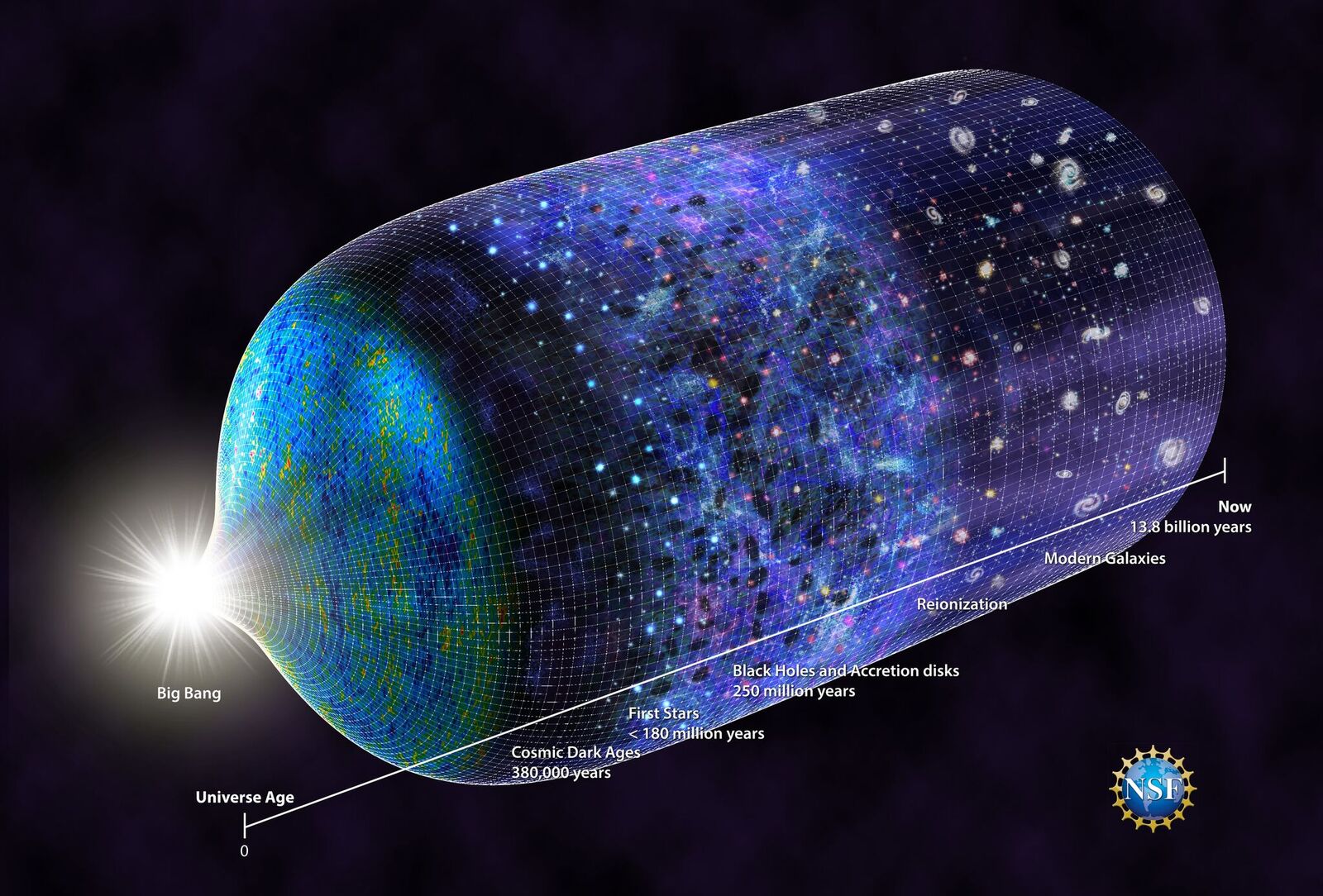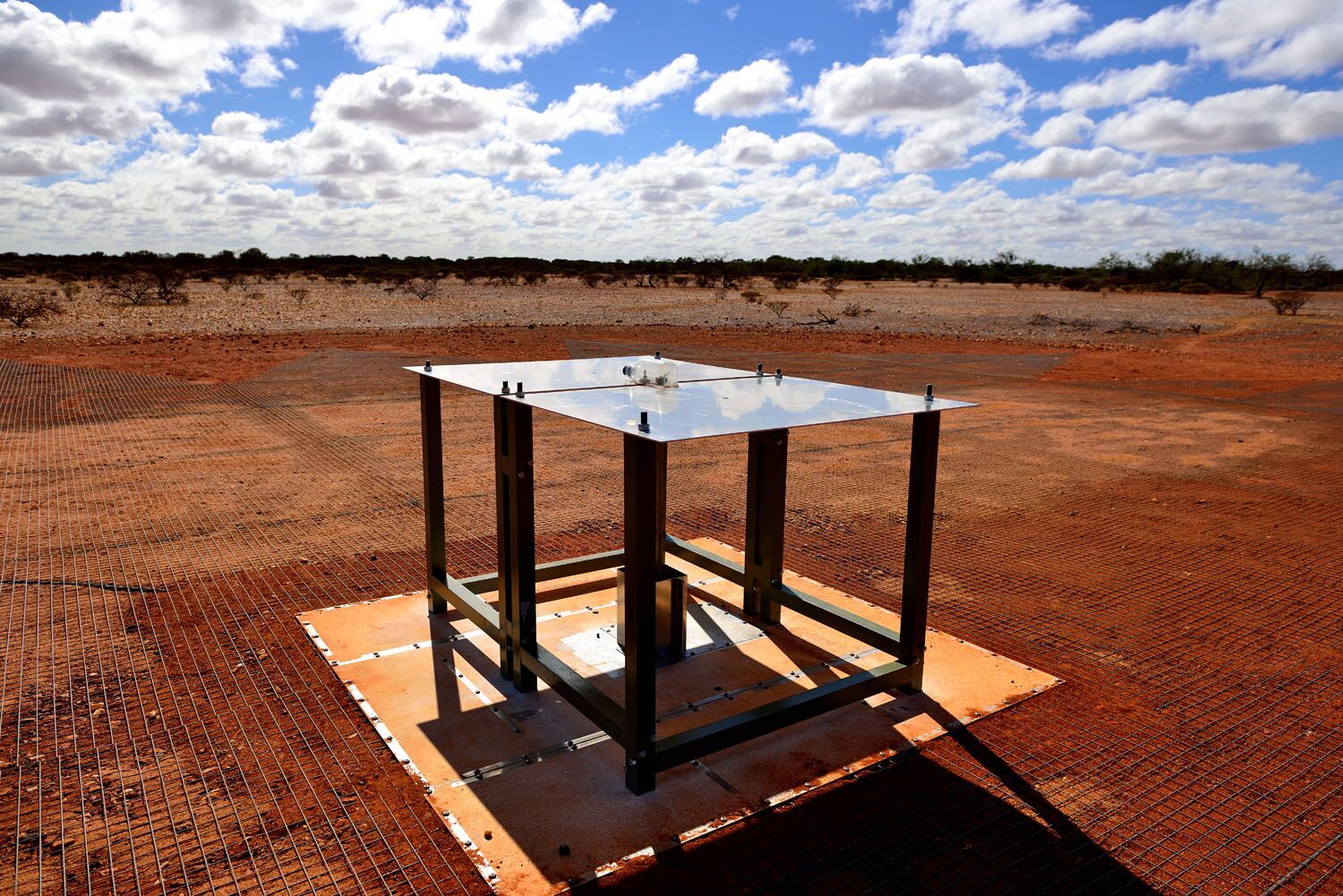After nearly a decade of listening with a custom-built, table-sized antenna at our Murchison Radio-astronomy Observatory in remote Western Australia, researchers have detected signs of the first stars to emerge in the Universe. Image: Artist’s rendering of how the first stars in the Universe may have looked (N.R.Fuller, National Science Foundation).
Looking up at the night sky on a clear evening you’ll see stars splashed across the sky like spilt milk. It’s a wonder to behold, and it might start you thinking about when the first stars were born.
After the Big Bang more than 13 billion years ago, the Universe cooled and went dark for millions of years. In the darkness, gravity pulled matter together until stars formed and burst into life, bringing the ‘cosmic dawn’.
Until now we didn’t know when the first stars emerged in the Universe.
US astronomers announced today that they have detected a signal from the first stars to have emerged in the early Universe about 180 million years after the Big Bang. To make this discovery they used a small radio telescope at our Murchison Radio-astronomy Observatory in Western Australia.
This new-found signal marks the closest astronomers have seen to the cosmic dawn, coming from 13.6 billion years back in the Universe’s history. (By contrast, our Sun is just four billion years old, a fairly recent newcomer to the cosmic web.)
Understanding the first stars is key to understanding the full story of our cosmic origins.
“Finding this miniscule signal has opened a new window on the early Universe,” says Dr Judd Bowman of Arizona State University whose team made this exciting discovery.
“The first stars are expected to be different than stars we see in the local Universe because they formed from the pristine primordial gas created after the Big Bang. This gas was almost entirely hydrogen and helium. In contrast, nearly all subsequent stars formed from gas that was enriched with heavier elements on the periodic table, such as carbon and oxygen.
“The first stars are responsible for seeding the early Universe with heavier elements and starting the processes that led to stars like our Sun,” says Judd.
This updated timeline of the Universe reflects the recent discovery that the first stars emerged by 180 million years after the Big Bang (N.R.Fuller, National Science Foundation).
The radio signal Judd’s team found was incredibly faint. It also fell in the region of the spectrum used by FM radio stations, making detection of this weak signal from most Earth-based sites impossible.
Judd has been running EDGES – the Experiment to Detect the Global Epoch of Reionization Signature – for 12 years. It is one of the most technically challenging radio astronomy experiments ever attempted.
Nine years ago he started doing observations from our outback observatory after searching for the best place on the planet for this work.
Located about 800 km north of Perth, our observatory is in an area with low population density. This remote location is naturally free of radio ‘noise’, which is essential if you’re listening for faint whispers from space. This unique characteristic is protected by a legislated ‘radio quiet’ zone, which keeps human-made activities that produce interfering radio signals to an absolute minimum.
The EDGES instrument at our Murchison Radio-astronomy Observatory in remote Western Australia.
“The infrastructure and logistical support that CSIRO has provided for EDGES has enabled our small team to focus on developing the new instrumentation and techniques needed for the experiment,” says Judd.
We developed the MRO for our own Australian Square Kilometre Array Pathfinder telescope. Along with ASKAP and EDGES, the MRO also hosts the Murchison Widefield Array, a low-frequency telescope that has been developed by an international collaboration led by Curtin University.
These telescopes are already making use of the radio-quiet nature of the site. In future, the MRO will also be home to 130,000 ground-based antennas that make up the low-frequency component of the international Square Kilometre Array.
According to Dr Robert Braun, Science Director at the Square Kilometre Array Organisation, “this is a powerful demonstration of what can be achieved with the combination of an excellent site and world-class engineering, boding well for the great discoveries that will be enabled by the Square Kilometre Array.”
ASKAP is part of the Australia Telescope National Facility which is managed by CSIRO. Operation of ASKAP is funded by the Australian Government with support from the National Collaborative Research Infrastructure Strategy. ASKAP uses the resources of the Pawsey Supercomputing Centre. Establishment of ASKAP, the Murchison Radio-astronomy Observatory and the Pawsey Supercomputing Centre are initiatives of the Australian Government, with support from the Government of Western Australia and the Science and Industry Endowment Fund. We acknowledge the Wajarri Yamaji people as the traditional owners of the Observatory site.





8th March 2018 at 6:14 pm
Great work! Not only does it expand the frontiers of Science, it expands our minds too. I can see applications from energy to telecommunications. This is the type of research that not only inspires, it lays the framework for so many possibilities. Keep it up!
8th March 2018 at 3:34 pm
More specifically, following on from Phil’s comments, please identify the wavelengths at which these observations were made. Is there a peer-reviewed journal paper reporting these results?
9th March 2018 at 9:32 am
Hi Mark,
You can read the peer reviewed journal paper here: http://www.nature.com/articles/nature25792
Regards,
Eliza
Social media team
8th March 2018 at 1:10 pm
In my view the Universe is infinite and to accept this theory of the Universe starting with one point in ‘time’ is not really easy for me to accept. Are not galaxies are continually collapsing into ‘black holes’ and being reborn through major bangs? As we have discovered our Galaxy is expanding and most likely will capture other galaxies to be come a critical mass to start collapsing into some future black hole. Life on our Earth doesn’t really register on the ‘time line’ of our galaxy, does it not?
7th March 2018 at 5:38 am
Come on Aussies are we really going to go down this track of feeding fake space stories to the masses. The firmament will always look the same let’s spend money on stories from around the 32 continents or how compressed air powered cars are easily built. Let’s be the most transparent government agency on the flat Earth and just make a statement that the theory of gravity was humans most ridiculous bedtime story. Geeks are Hot, be happy with real work to help humanity. Please stop wasting taxpayers money on space.
3rd March 2018 at 9:40 am
Could you explain please how the antenna works and how you can verify that the signal comes from very early stars? Perhaps there is another article in this… Thank you.
12th March 2018 at 1:01 pm
Hi there, Phil – great question! We asked the researcher involved, from Arizona State University, and here’s his response:
“The antenna is based on a dipole antenna, one of the classic antenna designs. It has two metal panels that feed into the radio receiver transferring the electric field of the incoming radio waves to the receiver. The simplest dipoles are made out of two wires, but we use larger metal panels because it broadens the range of wavelengths to which the antenna is sensitive.
Verification of the signal is a key question. There are a number of ways that the instrument (either the antenna or the receiver) could artificially make the bright radio noise from our own Milky Way galaxy look like the faint signal we report from our observations. We made dozens of tests to rule-out as many instrumental errors as possible. We also considered if there could be other astronomical causes of the signal. In our paper, we listed possible alternatives – for example regions of ionized gas in our own galaxy that can absorb some radio waves – but in each case they have properties that are inconsistent with the observations. Despite our verification steps, we are eager for the signal to be confirmed by another instrument.”
Thanks again,
Jesse